CHCECE005 Provide Care for Babies and Toddlers - Assessment
VerifiedAdded on 2023/06/18
|23
|3883
|470
AI Summary
This assessment covers short answer questions and case studies related to providing care for babies and toddlers. It includes topics such as SUDI, safe sleep practices, nappy changing, meal-time environment, toilet training, and appropriate food for different age groups.
Contribute Materials
Your contribution can guide someone’s learning journey. Share your
documents today.
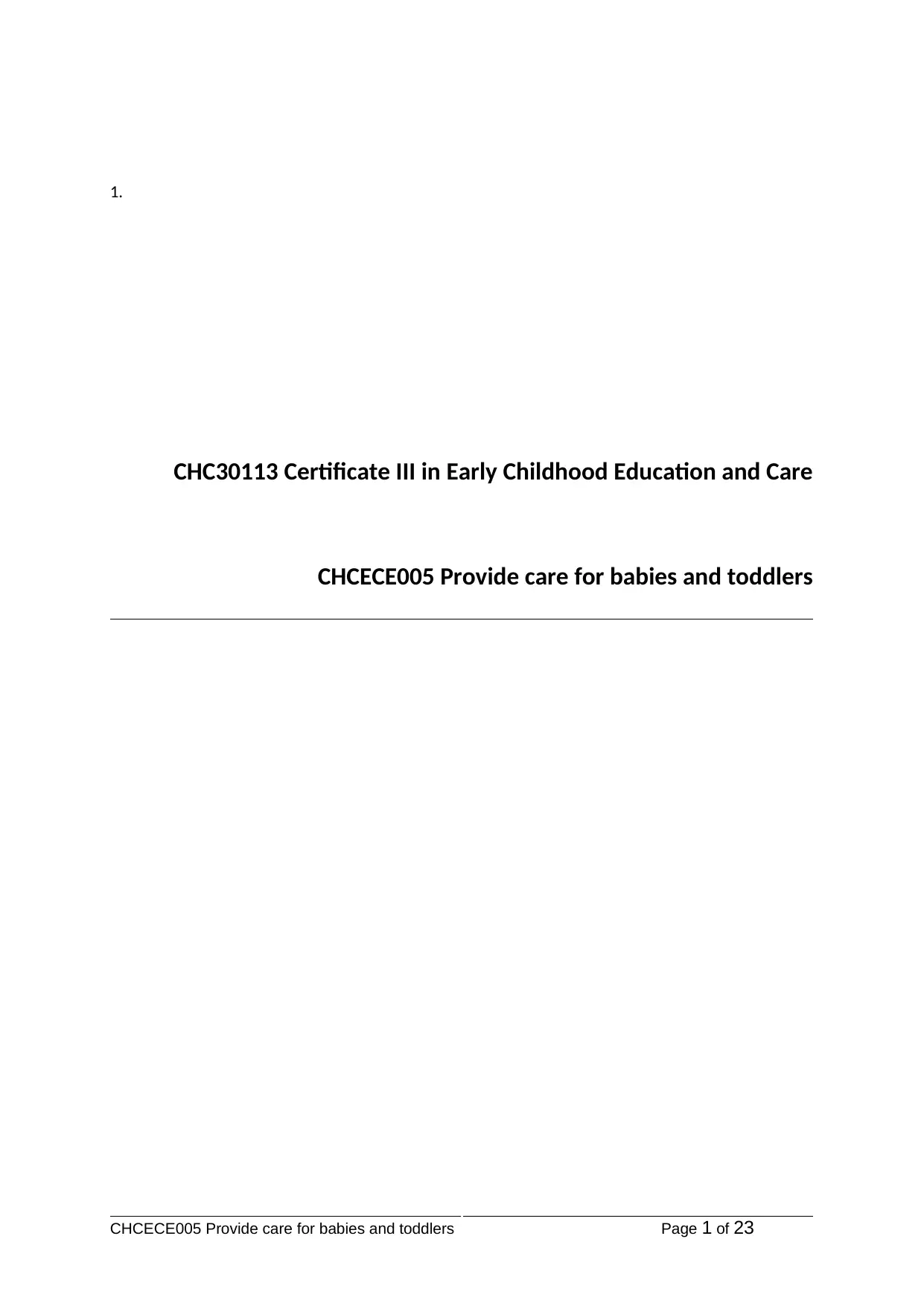
1.
CHC30113 Certificate III in Early Childhood Education and Care
CHCECE005 Provide care for babies and toddlers
CHCECE005 Provide care for babies and toddlers Page 1 of 23
CHC30113 Certificate III in Early Childhood Education and Care
CHCECE005 Provide care for babies and toddlers
CHCECE005 Provide care for babies and toddlers Page 1 of 23
Secure Best Marks with AI Grader
Need help grading? Try our AI Grader for instant feedback on your assignments.

.
2
2
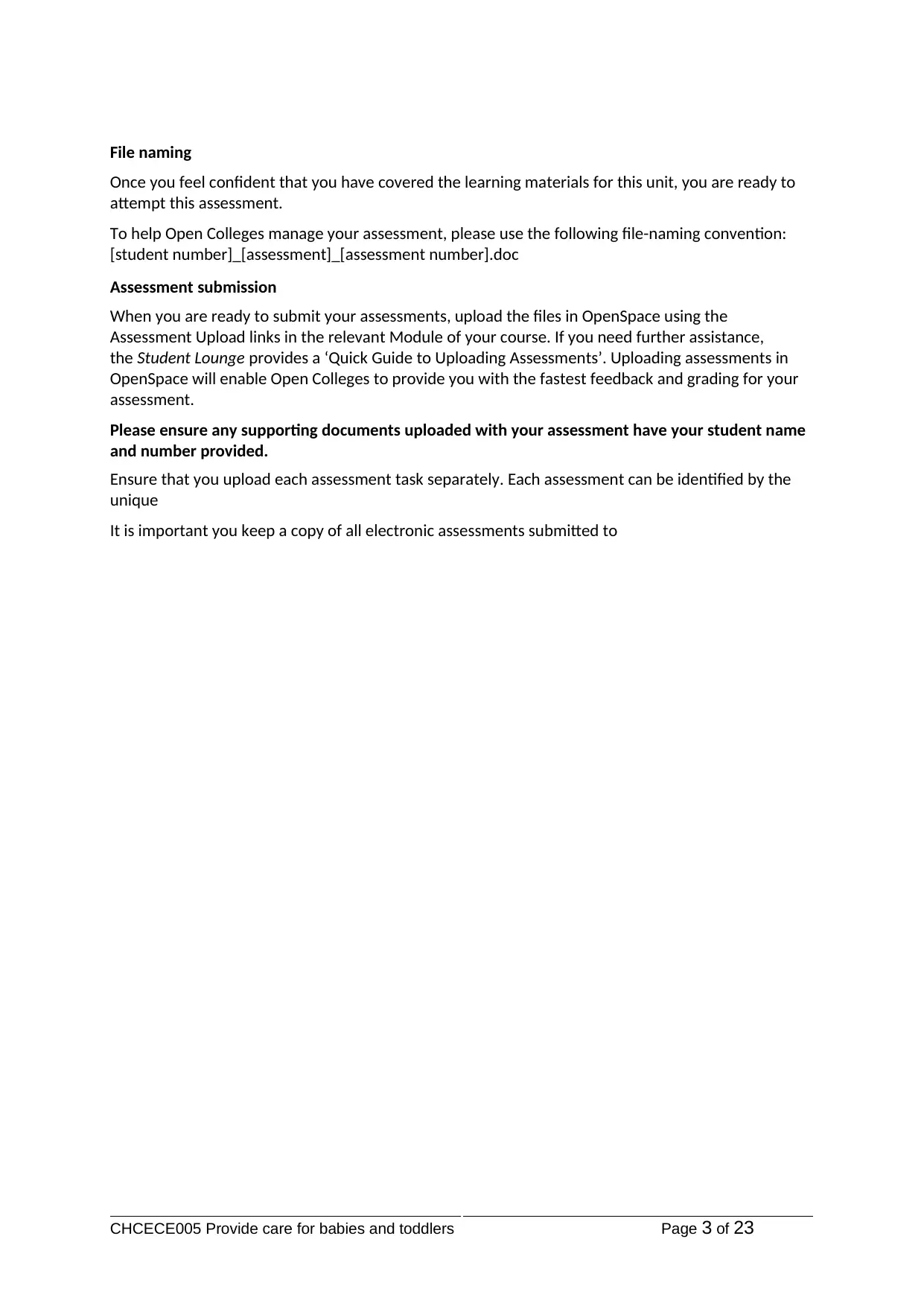
File naming
Once you feel confident that you have covered the learning materials for this unit, you are ready to
attempt this assessment.
To help Open Colleges manage your assessment, please use the following file-naming convention:
[student number]_[assessment]_[assessment number].doc
Assessment submission
When you are ready to submit your assessments, upload the files in OpenSpace using the
Assessment Upload links in the relevant Module of your course. If you need further assistance,
the Student Lounge provides a ‘Quick Guide to Uploading Assessments’. Uploading assessments in
OpenSpace will enable Open Colleges to provide you with the fastest feedback and grading for your
assessment.
Please ensure any supporting documents uploaded with your assessment have your student name
and number provided.
Ensure that you upload each assessment task separately. Each assessment can be identified by the
unique
It is important you keep a copy of all electronic assessments submitted to
CHCECE005 Provide care for babies and toddlers Page 3 of 23
Once you feel confident that you have covered the learning materials for this unit, you are ready to
attempt this assessment.
To help Open Colleges manage your assessment, please use the following file-naming convention:
[student number]_[assessment]_[assessment number].doc
Assessment submission
When you are ready to submit your assessments, upload the files in OpenSpace using the
Assessment Upload links in the relevant Module of your course. If you need further assistance,
the Student Lounge provides a ‘Quick Guide to Uploading Assessments’. Uploading assessments in
OpenSpace will enable Open Colleges to provide you with the fastest feedback and grading for your
assessment.
Please ensure any supporting documents uploaded with your assessment have your student name
and number provided.
Ensure that you upload each assessment task separately. Each assessment can be identified by the
unique
It is important you keep a copy of all electronic assessments submitted to
CHCECE005 Provide care for babies and toddlers Page 3 of 23

31835B/01 Written assessment
Part A - Short answer questions
Student instructions
Answer each of the following questions.
To answer questions accurately, you may refer to applicable legislation including the National
Quality Standard and Education and Care Services National Regulations, along with the
Belonging, Being and Becoming – The Early Years Learning Framework, Early Childhood Australia
Code of Ethics, policies and procedures common to early childhood education and care services,
position descriptions detailing an educator’s duty of care responsibilities, and/or other sources
such as professional readings along with the course textbook and identified key resources.
When referring to early childhood education and care service policies and procedures or position
descriptions, please submit with your assessment to support your answer.
Assessment number Assessment deliverables
31835B/01 Written assessment
4
Part A - Short answer questions
Student instructions
Answer each of the following questions.
To answer questions accurately, you may refer to applicable legislation including the National
Quality Standard and Education and Care Services National Regulations, along with the
Belonging, Being and Becoming – The Early Years Learning Framework, Early Childhood Australia
Code of Ethics, policies and procedures common to early childhood education and care services,
position descriptions detailing an educator’s duty of care responsibilities, and/or other sources
such as professional readings along with the course textbook and identified key resources.
When referring to early childhood education and care service policies and procedures or position
descriptions, please submit with your assessment to support your answer.
Assessment number Assessment deliverables
31835B/01 Written assessment
4
Secure Best Marks with AI Grader
Need help grading? Try our AI Grader for instant feedback on your assignments.
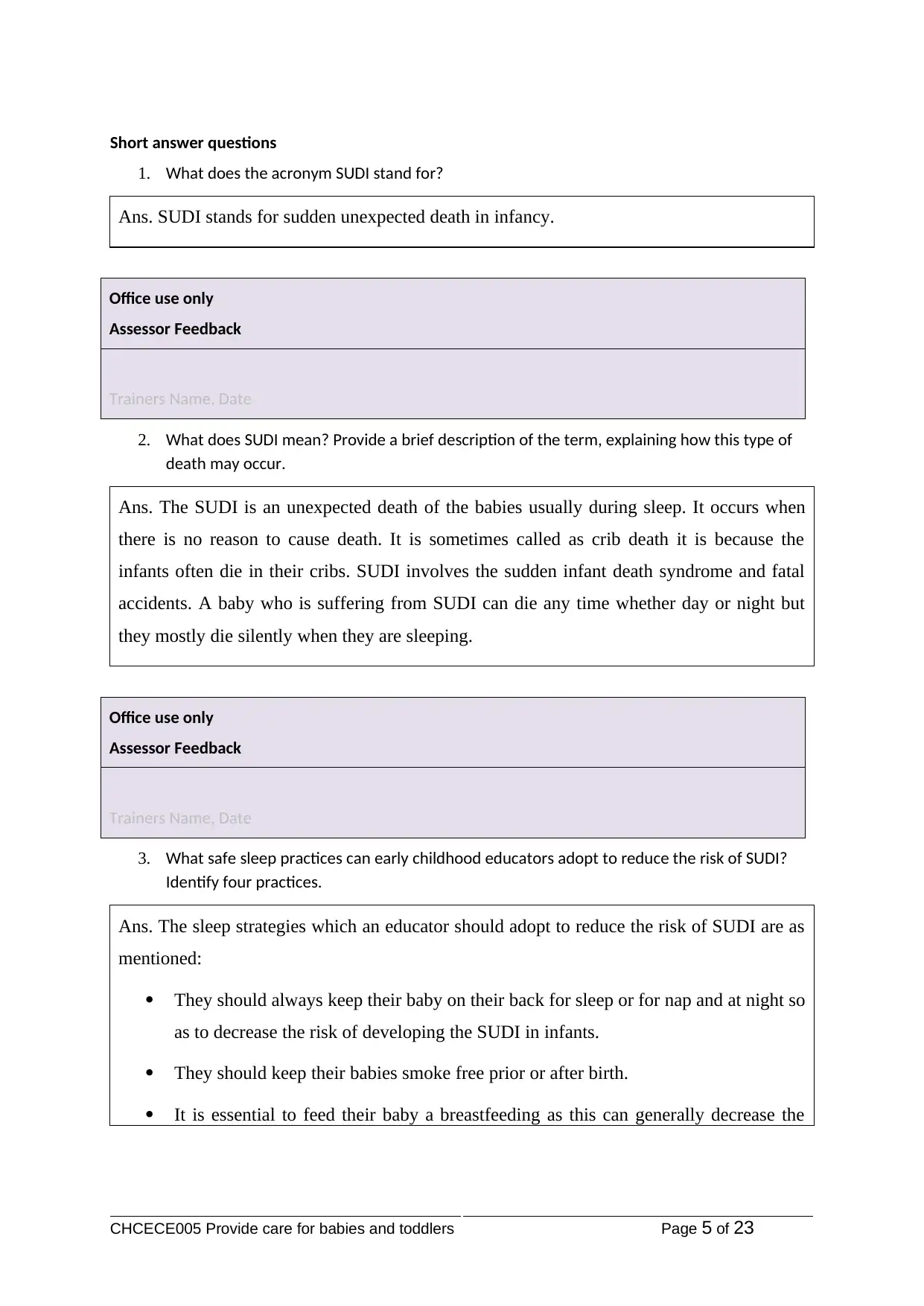
Short answer questions
1. What does the acronym SUDI stand for?
Ans. SUDI stands for sudden unexpected death in infancy.
Office use only
Assessor Feedback
Trainers Name, Date
2. What does SUDI mean? Provide a brief description of the term, explaining how this type of
death may occur.
Ans. The SUDI is an unexpected death of the babies usually during sleep. It occurs when
there is no reason to cause death. It is sometimes called as crib death it is because the
infants often die in their cribs. SUDI involves the sudden infant death syndrome and fatal
accidents. A baby who is suffering from SUDI can die any time whether day or night but
they mostly die silently when they are sleeping.
Office use only
Assessor Feedback
Trainers Name, Date
3. What safe sleep practices can early childhood educators adopt to reduce the risk of SUDI?
Identify four practices.
Ans. The sleep strategies which an educator should adopt to reduce the risk of SUDI are as
mentioned:
They should always keep their baby on their back for sleep or for nap and at night so
as to decrease the risk of developing the SUDI in infants.
They should keep their babies smoke free prior or after birth.
It is essential to feed their baby a breastfeeding as this can generally decrease the
CHCECE005 Provide care for babies and toddlers Page 5 of 23
1. What does the acronym SUDI stand for?
Ans. SUDI stands for sudden unexpected death in infancy.
Office use only
Assessor Feedback
Trainers Name, Date
2. What does SUDI mean? Provide a brief description of the term, explaining how this type of
death may occur.
Ans. The SUDI is an unexpected death of the babies usually during sleep. It occurs when
there is no reason to cause death. It is sometimes called as crib death it is because the
infants often die in their cribs. SUDI involves the sudden infant death syndrome and fatal
accidents. A baby who is suffering from SUDI can die any time whether day or night but
they mostly die silently when they are sleeping.
Office use only
Assessor Feedback
Trainers Name, Date
3. What safe sleep practices can early childhood educators adopt to reduce the risk of SUDI?
Identify four practices.
Ans. The sleep strategies which an educator should adopt to reduce the risk of SUDI are as
mentioned:
They should always keep their baby on their back for sleep or for nap and at night so
as to decrease the risk of developing the SUDI in infants.
They should keep their babies smoke free prior or after birth.
It is essential to feed their baby a breastfeeding as this can generally decrease the
CHCECE005 Provide care for babies and toddlers Page 5 of 23
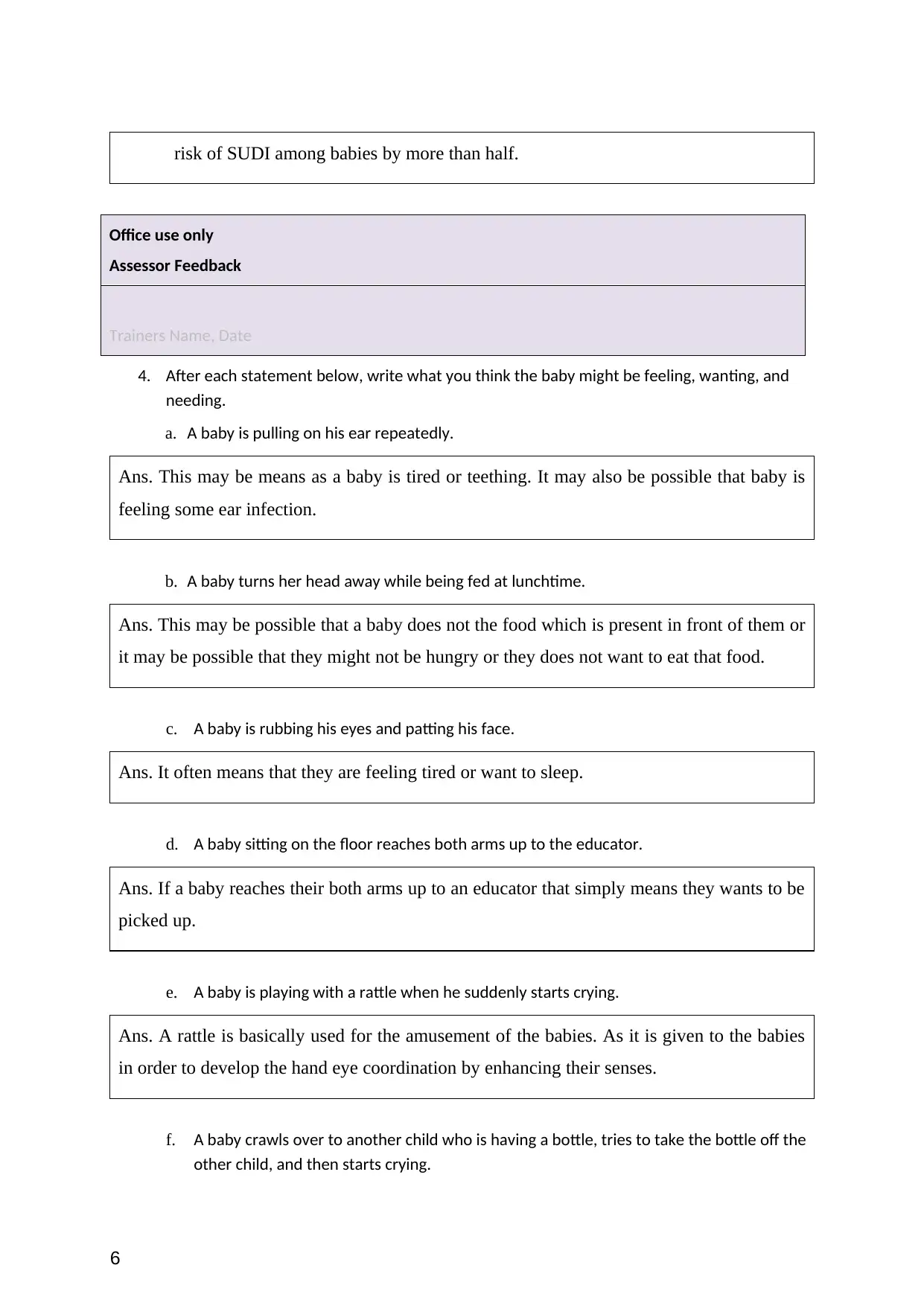
risk of SUDI among babies by more than half.
Office use only
Assessor Feedback
Trainers Name, Date
4. After each statement below, write what you think the baby might be feeling, wanting, and
needing.
a. A baby is pulling on his ear repeatedly.
Ans. This may be means as a baby is tired or teething. It may also be possible that baby is
feeling some ear infection.
b. A baby turns her head away while being fed at lunchtime.
Ans. This may be possible that a baby does not the food which is present in front of them or
it may be possible that they might not be hungry or they does not want to eat that food.
c. A baby is rubbing his eyes and patting his face.
Ans. It often means that they are feeling tired or want to sleep.
d. A baby sitting on the floor reaches both arms up to the educator.
Ans. If a baby reaches their both arms up to an educator that simply means they wants to be
picked up.
e. A baby is playing with a rattle when he suddenly starts crying.
Ans. A rattle is basically used for the amusement of the babies. As it is given to the babies
in order to develop the hand eye coordination by enhancing their senses.
f. A baby crawls over to another child who is having a bottle, tries to take the bottle off the
other child, and then starts crying.
6
Office use only
Assessor Feedback
Trainers Name, Date
4. After each statement below, write what you think the baby might be feeling, wanting, and
needing.
a. A baby is pulling on his ear repeatedly.
Ans. This may be means as a baby is tired or teething. It may also be possible that baby is
feeling some ear infection.
b. A baby turns her head away while being fed at lunchtime.
Ans. This may be possible that a baby does not the food which is present in front of them or
it may be possible that they might not be hungry or they does not want to eat that food.
c. A baby is rubbing his eyes and patting his face.
Ans. It often means that they are feeling tired or want to sleep.
d. A baby sitting on the floor reaches both arms up to the educator.
Ans. If a baby reaches their both arms up to an educator that simply means they wants to be
picked up.
e. A baby is playing with a rattle when he suddenly starts crying.
Ans. A rattle is basically used for the amusement of the babies. As it is given to the babies
in order to develop the hand eye coordination by enhancing their senses.
f. A baby crawls over to another child who is having a bottle, tries to take the bottle off the
other child, and then starts crying.
6
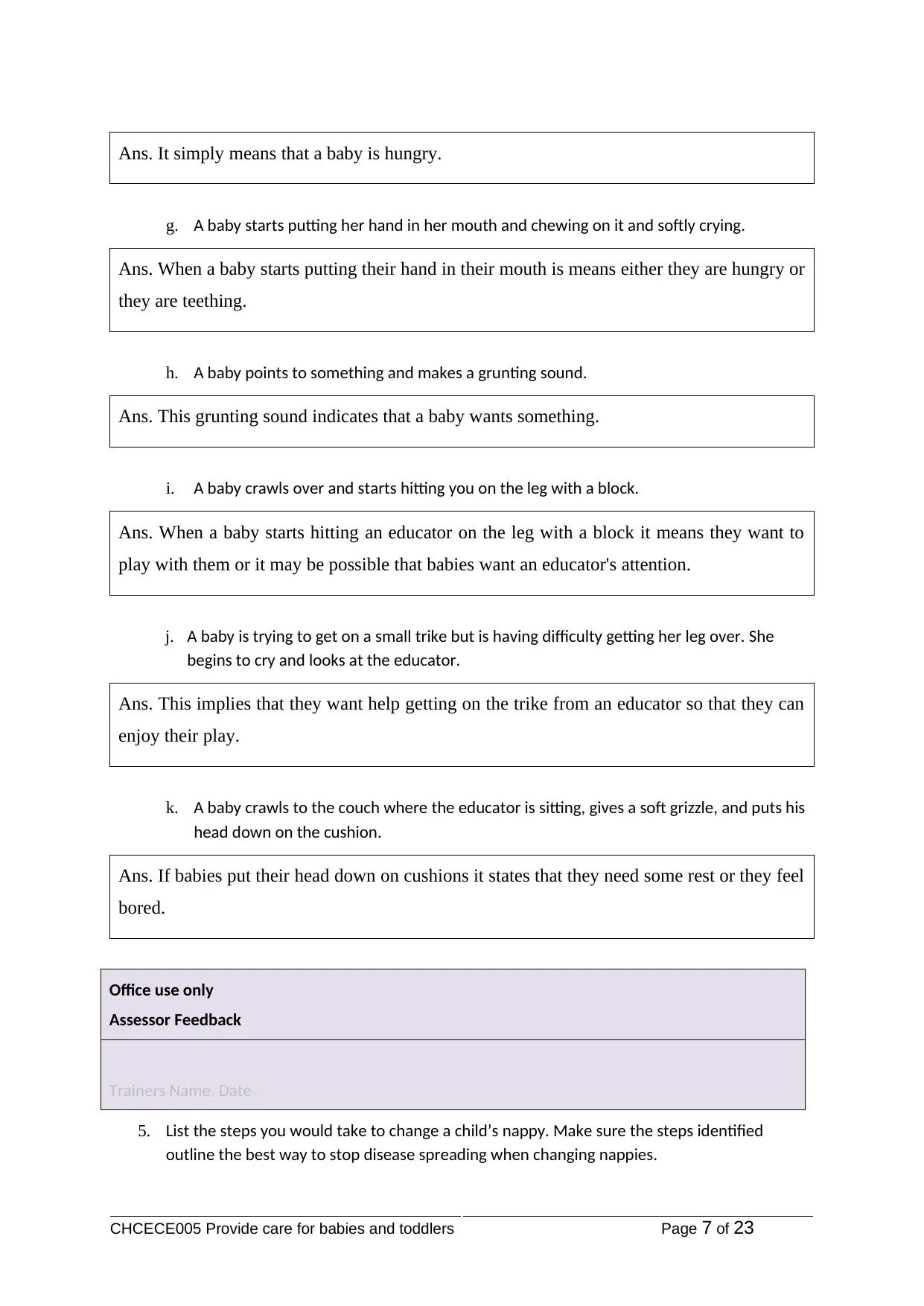
Ans. It simply means that a baby is hungry.
g. A baby starts putting her hand in her mouth and chewing on it and softly crying.
Ans. When a baby starts putting their hand in their mouth is means either they are hungry or
they are teething.
h. A baby points to something and makes a grunting sound.
Ans. This grunting sound indicates that a baby wants something.
i. A baby crawls over and starts hitting you on the leg with a block.
Ans. When a baby starts hitting an educator on the leg with a block it means they want to
play with them or it may be possible that babies want an educator's attention.
j. A baby is trying to get on a small trike but is having difficulty getting her leg over. She
begins to cry and looks at the educator.
Ans. This implies that they want help getting on the trike from an educator so that they can
enjoy their play.
k. A baby crawls to the couch where the educator is sitting, gives a soft grizzle, and puts his
head down on the cushion.
Ans. If babies put their head down on cushions it states that they need some rest or they feel
bored.
Office use only
Assessor Feedback
Trainers Name, Date
5. List the steps you would take to change a child’s nappy. Make sure the steps identified
outline the best way to stop disease spreading when changing nappies.
CHCECE005 Provide care for babies and toddlers Page 7 of 23
g. A baby starts putting her hand in her mouth and chewing on it and softly crying.
Ans. When a baby starts putting their hand in their mouth is means either they are hungry or
they are teething.
h. A baby points to something and makes a grunting sound.
Ans. This grunting sound indicates that a baby wants something.
i. A baby crawls over and starts hitting you on the leg with a block.
Ans. When a baby starts hitting an educator on the leg with a block it means they want to
play with them or it may be possible that babies want an educator's attention.
j. A baby is trying to get on a small trike but is having difficulty getting her leg over. She
begins to cry and looks at the educator.
Ans. This implies that they want help getting on the trike from an educator so that they can
enjoy their play.
k. A baby crawls to the couch where the educator is sitting, gives a soft grizzle, and puts his
head down on the cushion.
Ans. If babies put their head down on cushions it states that they need some rest or they feel
bored.
Office use only
Assessor Feedback
Trainers Name, Date
5. List the steps you would take to change a child’s nappy. Make sure the steps identified
outline the best way to stop disease spreading when changing nappies.
CHCECE005 Provide care for babies and toddlers Page 7 of 23
Paraphrase This Document
Need a fresh take? Get an instant paraphrase of this document with our AI Paraphraser

Ans. 1. An educator must wash the hands of the babies with warm running water and soap.
2. They should clean the diaper area and also clean the baby with disposable wipes
if they are out of their homes.
3. An educator must dispose of the dirty nappies in a right way according to the
nappies changing procedure.
6.
Office use only
Assessor Feedback
Trainers Name, Date
6. Describe the practices you could implementing an early childhood education and care service
to ensure that each child has clean bedding for rest and sleep times.
Ans. An educator should provide some enough space in between cots or beds to insure the
babies using them cannot physically trouble one another while sleeping.
7.
Office use only
Assessor Feedback
Trainers Name, Date
7. Briefly outline why it is important for babies to be fed one at a time.
Ans. Feeding babies is very important as it provides nutrition to the new born. It is
important to fed one at a time because feeding each baby on an individual schedule and do
not demand all the infants to be hungry at the same time.
Office use only
Assessor Feedback
8
2. They should clean the diaper area and also clean the baby with disposable wipes
if they are out of their homes.
3. An educator must dispose of the dirty nappies in a right way according to the
nappies changing procedure.
6.
Office use only
Assessor Feedback
Trainers Name, Date
6. Describe the practices you could implementing an early childhood education and care service
to ensure that each child has clean bedding for rest and sleep times.
Ans. An educator should provide some enough space in between cots or beds to insure the
babies using them cannot physically trouble one another while sleeping.
7.
Office use only
Assessor Feedback
Trainers Name, Date
7. Briefly outline why it is important for babies to be fed one at a time.
Ans. Feeding babies is very important as it provides nutrition to the new born. It is
important to fed one at a time because feeding each baby on an individual schedule and do
not demand all the infants to be hungry at the same time.
Office use only
Assessor Feedback
8
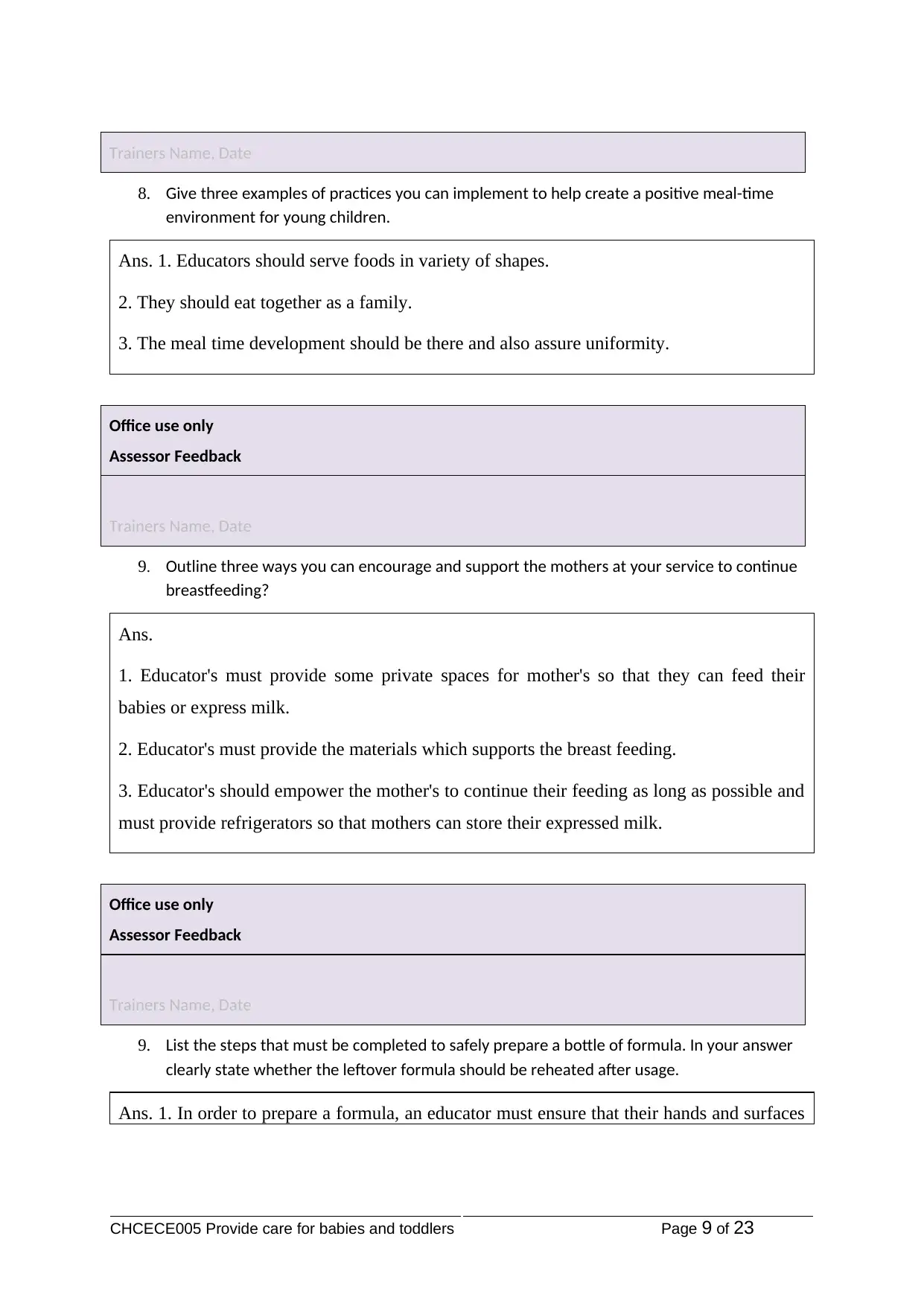
Trainers Name, Date
8. Give three examples of practices you can implement to help create a positive meal-time
environment for young children.
Ans. 1. Educators should serve foods in variety of shapes.
2. They should eat together as a family.
3. The meal time development should be there and also assure uniformity.
Office use only
Assessor Feedback
Trainers Name, Date
9. Outline three ways you can encourage and support the mothers at your service to continue
breastfeeding?
Ans.
1. Educator's must provide some private spaces for mother's so that they can feed their
babies or express milk.
2. Educator's must provide the materials which supports the breast feeding.
3. Educator's should empower the mother's to continue their feeding as long as possible and
must provide refrigerators so that mothers can store their expressed milk.
Office use only
Assessor Feedback
Trainers Name, Date
9. List the steps that must be completed to safely prepare a bottle of formula. In your answer
clearly state whether the leftover formula should be reheated after usage.
Ans. 1. In order to prepare a formula, an educator must ensure that their hands and surfaces
CHCECE005 Provide care for babies and toddlers Page 9 of 23
8. Give three examples of practices you can implement to help create a positive meal-time
environment for young children.
Ans. 1. Educators should serve foods in variety of shapes.
2. They should eat together as a family.
3. The meal time development should be there and also assure uniformity.
Office use only
Assessor Feedback
Trainers Name, Date
9. Outline three ways you can encourage and support the mothers at your service to continue
breastfeeding?
Ans.
1. Educator's must provide some private spaces for mother's so that they can feed their
babies or express milk.
2. Educator's must provide the materials which supports the breast feeding.
3. Educator's should empower the mother's to continue their feeding as long as possible and
must provide refrigerators so that mothers can store their expressed milk.
Office use only
Assessor Feedback
Trainers Name, Date
9. List the steps that must be completed to safely prepare a bottle of formula. In your answer
clearly state whether the leftover formula should be reheated after usage.
Ans. 1. In order to prepare a formula, an educator must ensure that their hands and surfaces
CHCECE005 Provide care for babies and toddlers Page 9 of 23
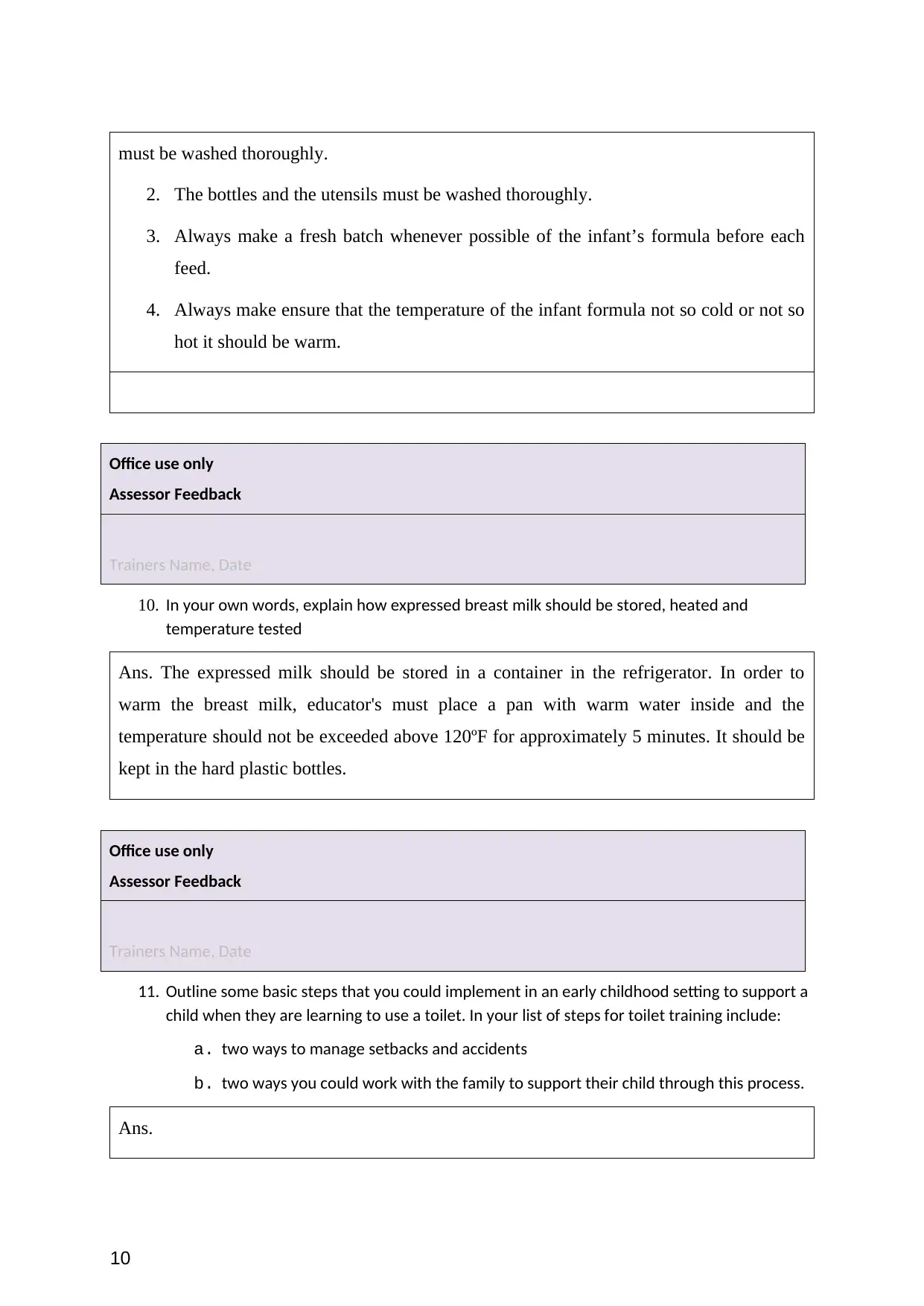
must be washed thoroughly.
2. The bottles and the utensils must be washed thoroughly.
3. Always make a fresh batch whenever possible of the infant’s formula before each
feed.
4. Always make ensure that the temperature of the infant formula not so cold or not so
hot it should be warm.
Office use only
Assessor Feedback
Trainers Name, Date
10. In your own words, explain how expressed breast milk should be stored, heated and
temperature tested
Ans. The expressed milk should be stored in a container in the refrigerator. In order to
warm the breast milk, educator's must place a pan with warm water inside and the
temperature should not be exceeded above 120ºF for approximately 5 minutes. It should be
kept in the hard plastic bottles.
Office use only
Assessor Feedback
Trainers Name, Date
11. Outline some basic steps that you could implement in an early childhood setting to support a
child when they are learning to use a toilet. In your list of steps for toilet training include:
a. two ways to manage setbacks and accidents
b. two ways you could work with the family to support their child through this process.
Ans.
10
2. The bottles and the utensils must be washed thoroughly.
3. Always make a fresh batch whenever possible of the infant’s formula before each
feed.
4. Always make ensure that the temperature of the infant formula not so cold or not so
hot it should be warm.
Office use only
Assessor Feedback
Trainers Name, Date
10. In your own words, explain how expressed breast milk should be stored, heated and
temperature tested
Ans. The expressed milk should be stored in a container in the refrigerator. In order to
warm the breast milk, educator's must place a pan with warm water inside and the
temperature should not be exceeded above 120ºF for approximately 5 minutes. It should be
kept in the hard plastic bottles.
Office use only
Assessor Feedback
Trainers Name, Date
11. Outline some basic steps that you could implement in an early childhood setting to support a
child when they are learning to use a toilet. In your list of steps for toilet training include:
a. two ways to manage setbacks and accidents
b. two ways you could work with the family to support their child through this process.
Ans.
10
Secure Best Marks with AI Grader
Need help grading? Try our AI Grader for instant feedback on your assignments.
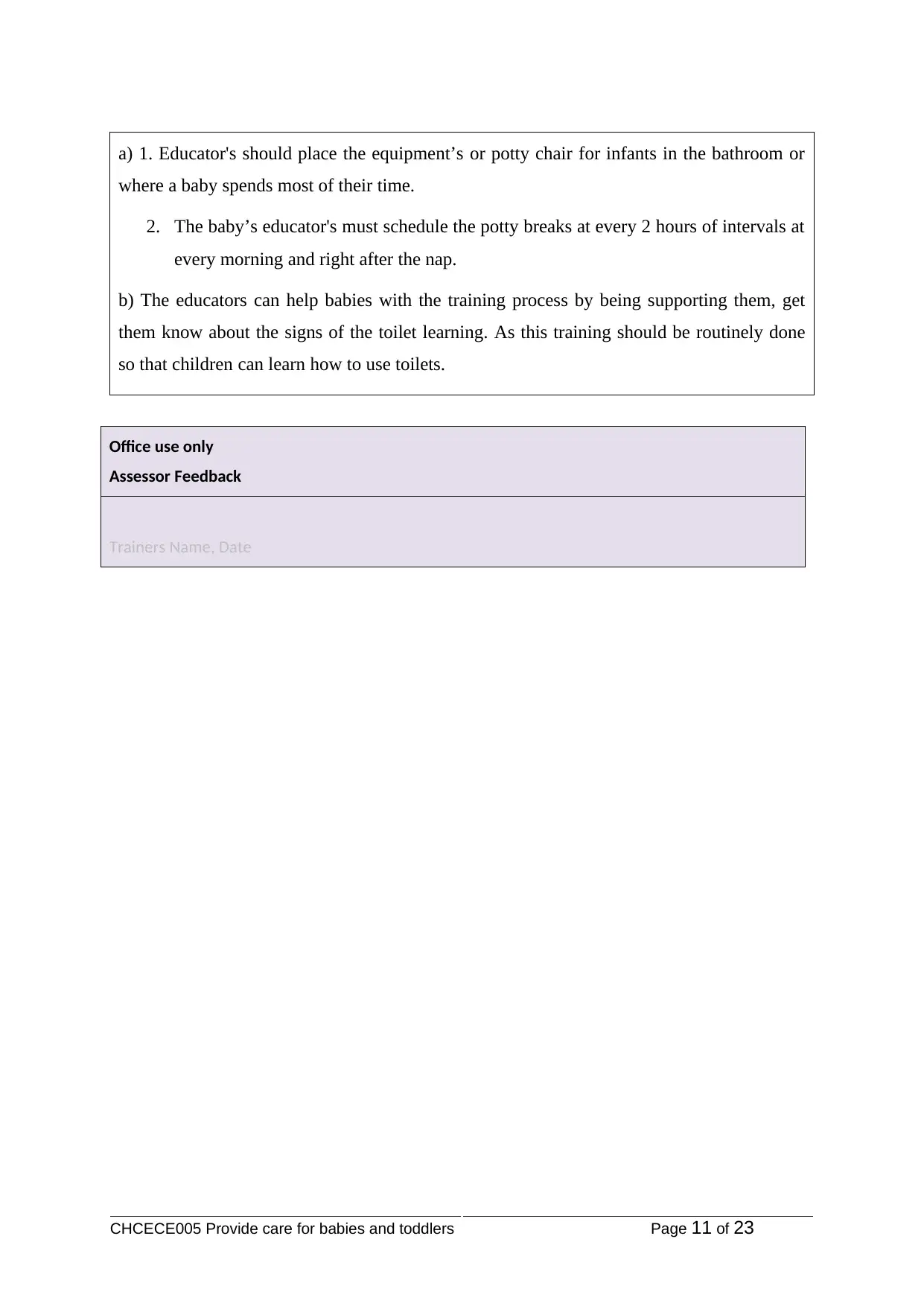
a) 1. Educator's should place the equipment’s or potty chair for infants in the bathroom or
where a baby spends most of their time.
2. The baby’s educator's must schedule the potty breaks at every 2 hours of intervals at
every morning and right after the nap.
b) The educators can help babies with the training process by being supporting them, get
them know about the signs of the toilet learning. As this training should be routinely done
so that children can learn how to use toilets.
Office use only
Assessor Feedback
Trainers Name, Date
CHCECE005 Provide care for babies and toddlers Page 11 of 23
where a baby spends most of their time.
2. The baby’s educator's must schedule the potty breaks at every 2 hours of intervals at
every morning and right after the nap.
b) The educators can help babies with the training process by being supporting them, get
them know about the signs of the toilet learning. As this training should be routinely done
so that children can learn how to use toilets.
Office use only
Assessor Feedback
Trainers Name, Date
CHCECE005 Provide care for babies and toddlers Page 11 of 23
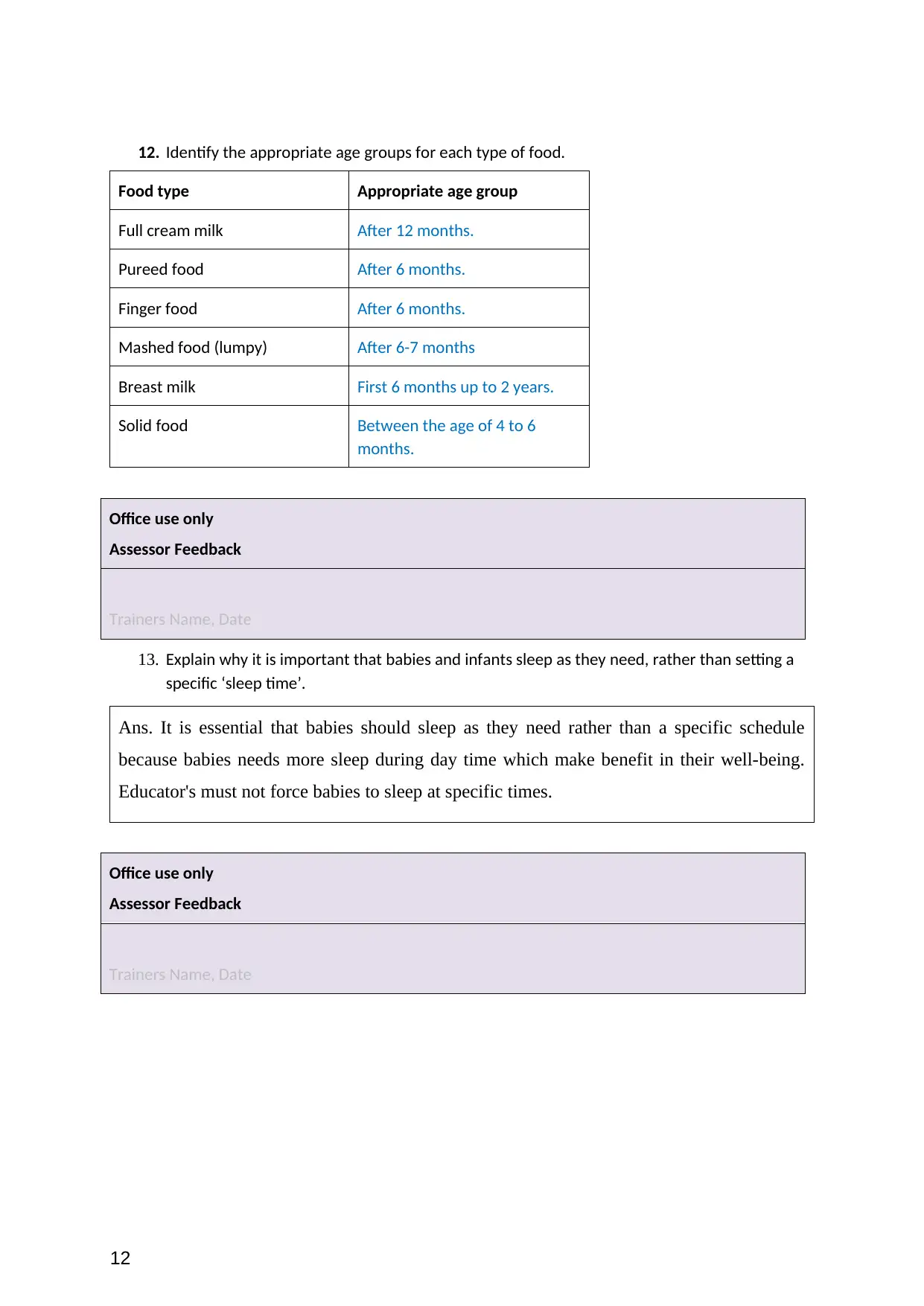
12. Identify the appropriate age groups for each type of food.
Food type Appropriate age group
Full cream milk After 12 months.
Pureed food After 6 months.
Finger food After 6 months.
Mashed food (lumpy) After 6-7 months
Breast milk First 6 months up to 2 years.
Solid food Between the age of 4 to 6
months.
Office use only
Assessor Feedback
Trainers Name, Date
13. Explain why it is important that babies and infants sleep as they need, rather than setting a
specific ‘sleep time’.
Ans. It is essential that babies should sleep as they need rather than a specific schedule
because babies needs more sleep during day time which make benefit in their well-being.
Educator's must not force babies to sleep at specific times.
Office use only
Assessor Feedback
Trainers Name, Date
12
Food type Appropriate age group
Full cream milk After 12 months.
Pureed food After 6 months.
Finger food After 6 months.
Mashed food (lumpy) After 6-7 months
Breast milk First 6 months up to 2 years.
Solid food Between the age of 4 to 6
months.
Office use only
Assessor Feedback
Trainers Name, Date
13. Explain why it is important that babies and infants sleep as they need, rather than setting a
specific ‘sleep time’.
Ans. It is essential that babies should sleep as they need rather than a specific schedule
because babies needs more sleep during day time which make benefit in their well-being.
Educator's must not force babies to sleep at specific times.
Office use only
Assessor Feedback
Trainers Name, Date
12

Part B - Case studies
Student instructions
Consider each of the below situations then answer the questions or complete the tasks that
follow.
To answer questions accurately, you may refer to applicable legislation including the National
Quality Standard and Education and Care Services National Regulations, along with the
Belonging, Being and Becoming – The Early Years Learning Framework, Early Childhood Australia
Code of Ethics, policies and procedures common to early childhood education and care services,
position descriptions detailing an educator’s duty of care responsibilities, and/or other sources
such as professional readings along with the course textbook and identified key resources.
If applicable, ensure you acknowledge and cite your sources accordingly. This is important
whether you use your own words or use the author’s own words.
When referring to early childhood education and care service policies and procedures or position
descriptions, please submit with your assessment to support your answer.
CHCECE005 Provide care for babies and toddlers Page 13 of 23
Student instructions
Consider each of the below situations then answer the questions or complete the tasks that
follow.
To answer questions accurately, you may refer to applicable legislation including the National
Quality Standard and Education and Care Services National Regulations, along with the
Belonging, Being and Becoming – The Early Years Learning Framework, Early Childhood Australia
Code of Ethics, policies and procedures common to early childhood education and care services,
position descriptions detailing an educator’s duty of care responsibilities, and/or other sources
such as professional readings along with the course textbook and identified key resources.
If applicable, ensure you acknowledge and cite your sources accordingly. This is important
whether you use your own words or use the author’s own words.
When referring to early childhood education and care service policies and procedures or position
descriptions, please submit with your assessment to support your answer.
CHCECE005 Provide care for babies and toddlers Page 13 of 23
Paraphrase This Document
Need a fresh take? Get an instant paraphrase of this document with our AI Paraphraser

Case studies
Case study 1
You have observed a new staff member make comments like, ‘Wow, that stinks! ‘and ‘Pooooh,
what does your mother feed you?’ when they have been helping children to use the toilet. When
you have explained to them that those types of statements are inappropriate, the staff member
has declared ‘Who cares? They are too young to understand anyway. It doesn’t matter.’
1. Describe why this could be considered an inappropriate way of interacting with a child.
Ans. According to the above case study, the staff member's behaviour was inappropriate as
they should not use such language in front of children's because in an early age they may
learn such things and they may adapt these things as their behaviour for lifetime.
Office use only
Assessor Feedback
Trainers Name, Date
2. Which part of the ECA Code of Ethics does this behaviour breach?
Ans. According to the code of ethics, an effective learning has been breached with this kind
of behaviour.
Office use only
Assessor Feedback
Trainers Name, Date
3. ’What quality area, standard and element of the National Quality Standard would you share
with this staff member to help them understand that their interactions are unacceptable?
Ans. In context with the National Quality Standard, the Quality Area 3 which is about
physical environment should be shared among the staff members in order to maintain their
behaviour in front of children's.
14
Case study 1
You have observed a new staff member make comments like, ‘Wow, that stinks! ‘and ‘Pooooh,
what does your mother feed you?’ when they have been helping children to use the toilet. When
you have explained to them that those types of statements are inappropriate, the staff member
has declared ‘Who cares? They are too young to understand anyway. It doesn’t matter.’
1. Describe why this could be considered an inappropriate way of interacting with a child.
Ans. According to the above case study, the staff member's behaviour was inappropriate as
they should not use such language in front of children's because in an early age they may
learn such things and they may adapt these things as their behaviour for lifetime.
Office use only
Assessor Feedback
Trainers Name, Date
2. Which part of the ECA Code of Ethics does this behaviour breach?
Ans. According to the code of ethics, an effective learning has been breached with this kind
of behaviour.
Office use only
Assessor Feedback
Trainers Name, Date
3. ’What quality area, standard and element of the National Quality Standard would you share
with this staff member to help them understand that their interactions are unacceptable?
Ans. In context with the National Quality Standard, the Quality Area 3 which is about
physical environment should be shared among the staff members in order to maintain their
behaviour in front of children's.
14
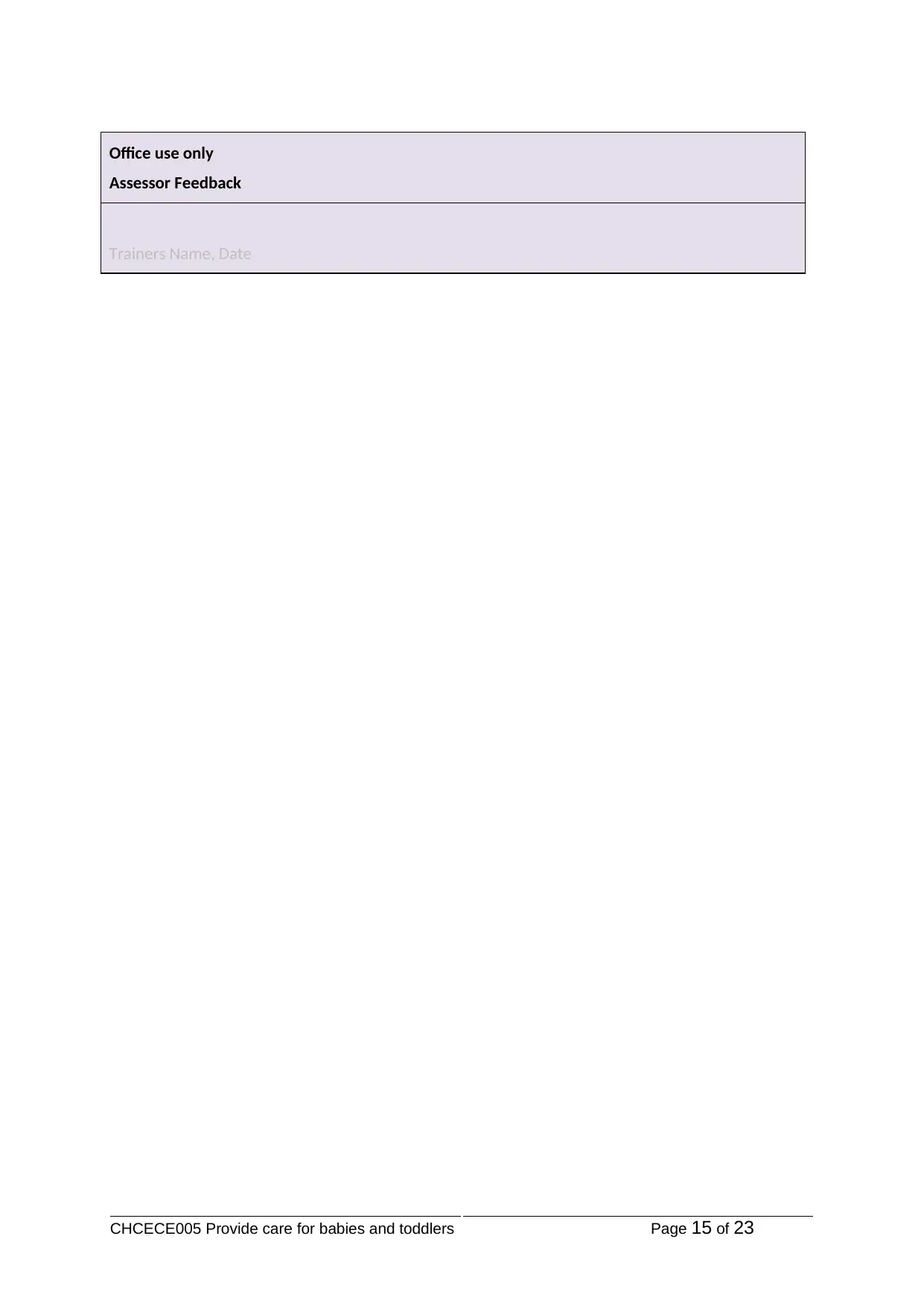
Office use only
Assessor Feedback
Trainers Name, Date
CHCECE005 Provide care for babies and toddlers Page 15 of 23
Assessor Feedback
Trainers Name, Date
CHCECE005 Provide care for babies and toddlers Page 15 of 23
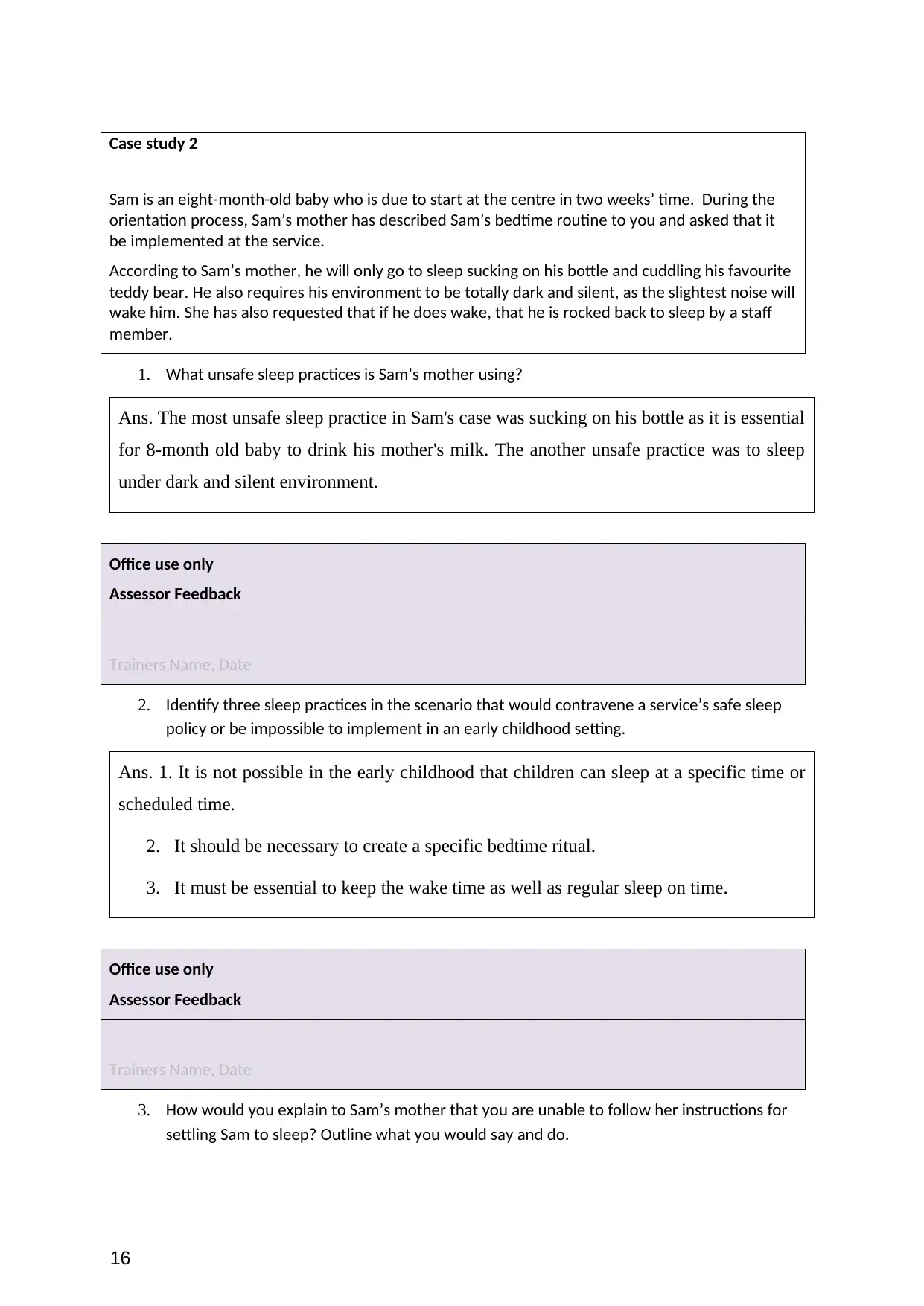
Case study 2
Sam is an eight-month-old baby who is due to start at the centre in two weeks’ time. During the
orientation process, Sam’s mother has described Sam’s bedtime routine to you and asked that it
be implemented at the service.
According to Sam’s mother, he will only go to sleep sucking on his bottle and cuddling his favourite
teddy bear. He also requires his environment to be totally dark and silent, as the slightest noise will
wake him. She has also requested that if he does wake, that he is rocked back to sleep by a staff
member.
1. What unsafe sleep practices is Sam’s mother using?
Ans. The most unsafe sleep practice in Sam's case was sucking on his bottle as it is essential
for 8-month old baby to drink his mother's milk. The another unsafe practice was to sleep
under dark and silent environment.
Office use only
Assessor Feedback
Trainers Name, Date
2. Identify three sleep practices in the scenario that would contravene a service’s safe sleep
policy or be impossible to implement in an early childhood setting.
Ans. 1. It is not possible in the early childhood that children can sleep at a specific time or
scheduled time.
2. It should be necessary to create a specific bedtime ritual.
3. It must be essential to keep the wake time as well as regular sleep on time.
Office use only
Assessor Feedback
Trainers Name, Date
3. How would you explain to Sam’s mother that you are unable to follow her instructions for
settling Sam to sleep? Outline what you would say and do.
16
Sam is an eight-month-old baby who is due to start at the centre in two weeks’ time. During the
orientation process, Sam’s mother has described Sam’s bedtime routine to you and asked that it
be implemented at the service.
According to Sam’s mother, he will only go to sleep sucking on his bottle and cuddling his favourite
teddy bear. He also requires his environment to be totally dark and silent, as the slightest noise will
wake him. She has also requested that if he does wake, that he is rocked back to sleep by a staff
member.
1. What unsafe sleep practices is Sam’s mother using?
Ans. The most unsafe sleep practice in Sam's case was sucking on his bottle as it is essential
for 8-month old baby to drink his mother's milk. The another unsafe practice was to sleep
under dark and silent environment.
Office use only
Assessor Feedback
Trainers Name, Date
2. Identify three sleep practices in the scenario that would contravene a service’s safe sleep
policy or be impossible to implement in an early childhood setting.
Ans. 1. It is not possible in the early childhood that children can sleep at a specific time or
scheduled time.
2. It should be necessary to create a specific bedtime ritual.
3. It must be essential to keep the wake time as well as regular sleep on time.
Office use only
Assessor Feedback
Trainers Name, Date
3. How would you explain to Sam’s mother that you are unable to follow her instructions for
settling Sam to sleep? Outline what you would say and do.
16
Secure Best Marks with AI Grader
Need help grading? Try our AI Grader for instant feedback on your assignments.
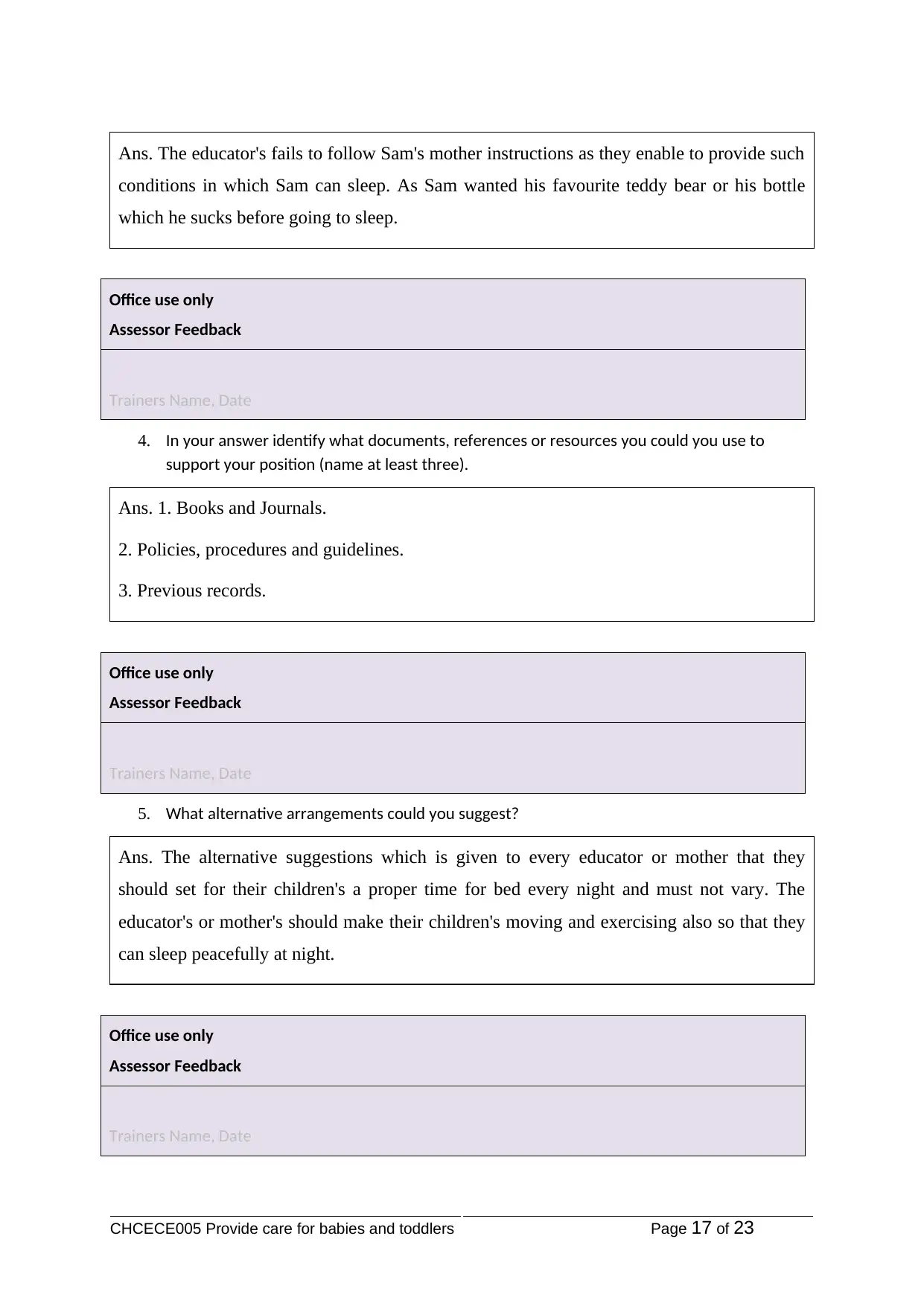
Ans. The educator's fails to follow Sam's mother instructions as they enable to provide such
conditions in which Sam can sleep. As Sam wanted his favourite teddy bear or his bottle
which he sucks before going to sleep.
Office use only
Assessor Feedback
Trainers Name, Date
4. In your answer identify what documents, references or resources you could you use to
support your position (name at least three).
Ans. 1. Books and Journals.
2. Policies, procedures and guidelines.
3. Previous records.
Office use only
Assessor Feedback
Trainers Name, Date
5. What alternative arrangements could you suggest?
Ans. The alternative suggestions which is given to every educator or mother that they
should set for their children's a proper time for bed every night and must not vary. The
educator's or mother's should make their children's moving and exercising also so that they
can sleep peacefully at night.
Office use only
Assessor Feedback
Trainers Name, Date
CHCECE005 Provide care for babies and toddlers Page 17 of 23
conditions in which Sam can sleep. As Sam wanted his favourite teddy bear or his bottle
which he sucks before going to sleep.
Office use only
Assessor Feedback
Trainers Name, Date
4. In your answer identify what documents, references or resources you could you use to
support your position (name at least three).
Ans. 1. Books and Journals.
2. Policies, procedures and guidelines.
3. Previous records.
Office use only
Assessor Feedback
Trainers Name, Date
5. What alternative arrangements could you suggest?
Ans. The alternative suggestions which is given to every educator or mother that they
should set for their children's a proper time for bed every night and must not vary. The
educator's or mother's should make their children's moving and exercising also so that they
can sleep peacefully at night.
Office use only
Assessor Feedback
Trainers Name, Date
CHCECE005 Provide care for babies and toddlers Page 17 of 23
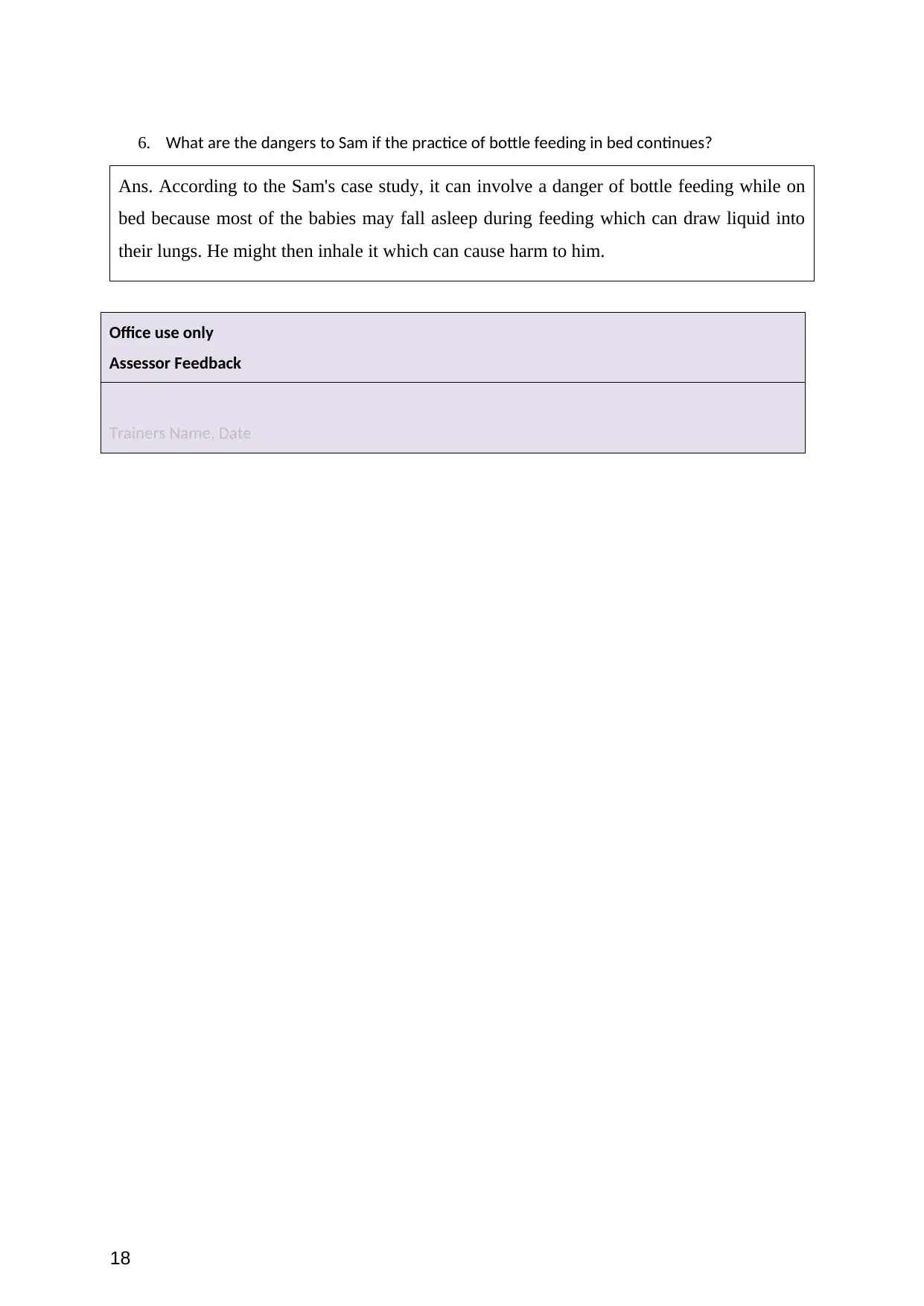
6. What are the dangers to Sam if the practice of bottle feeding in bed continues?
Ans. According to the Sam's case study, it can involve a danger of bottle feeding while on
bed because most of the babies may fall asleep during feeding which can draw liquid into
their lungs. He might then inhale it which can cause harm to him.
Office use only
Assessor Feedback
Trainers Name, Date
18
Ans. According to the Sam's case study, it can involve a danger of bottle feeding while on
bed because most of the babies may fall asleep during feeding which can draw liquid into
their lungs. He might then inhale it which can cause harm to him.
Office use only
Assessor Feedback
Trainers Name, Date
18

Part C - Project
Educators are required to provide a safe environment where babies can grow in confidence to
explore and learn, and practice new skills such as rolling over, sitting, crawling and walking.
Note: Your response must include all of the above skills.
You are required to design and set up a physical environment of your choice for babies aged between
birth and 15 months. The area needs to:
be safe and secure
provide opportunities for relaxed and physical contact with educators
accommodate individual needs of the children in care, in particular the ages.
Draw a picture in the space below, showing how you would set up the area for this age group.
Nominate either the indoor or outdoor area, consider the layout and show the equipment and any
other furnishings such as shelving, tables and chairs, or fixed play equipment and sandpits if outside.
You may prefer to draw on a separate piece of paper and attach it to this workbook.
Students
Please attach documents here OR copy and paste a photo of your design here.
Note: When attaching separate documents, please ensure that these have your full
student name and number provided on the actual document.
Office use only
Assessor Feedback
Trainers Name, Date
CHCECE005 Provide care for babies and toddlers Page 19 of 23
Educators are required to provide a safe environment where babies can grow in confidence to
explore and learn, and practice new skills such as rolling over, sitting, crawling and walking.
Note: Your response must include all of the above skills.
You are required to design and set up a physical environment of your choice for babies aged between
birth and 15 months. The area needs to:
be safe and secure
provide opportunities for relaxed and physical contact with educators
accommodate individual needs of the children in care, in particular the ages.
Draw a picture in the space below, showing how you would set up the area for this age group.
Nominate either the indoor or outdoor area, consider the layout and show the equipment and any
other furnishings such as shelving, tables and chairs, or fixed play equipment and sandpits if outside.
You may prefer to draw on a separate piece of paper and attach it to this workbook.
Students
Please attach documents here OR copy and paste a photo of your design here.
Note: When attaching separate documents, please ensure that these have your full
student name and number provided on the actual document.
Office use only
Assessor Feedback
Trainers Name, Date
CHCECE005 Provide care for babies and toddlers Page 19 of 23
Paraphrase This Document
Need a fresh take? Get an instant paraphrase of this document with our AI Paraphraser
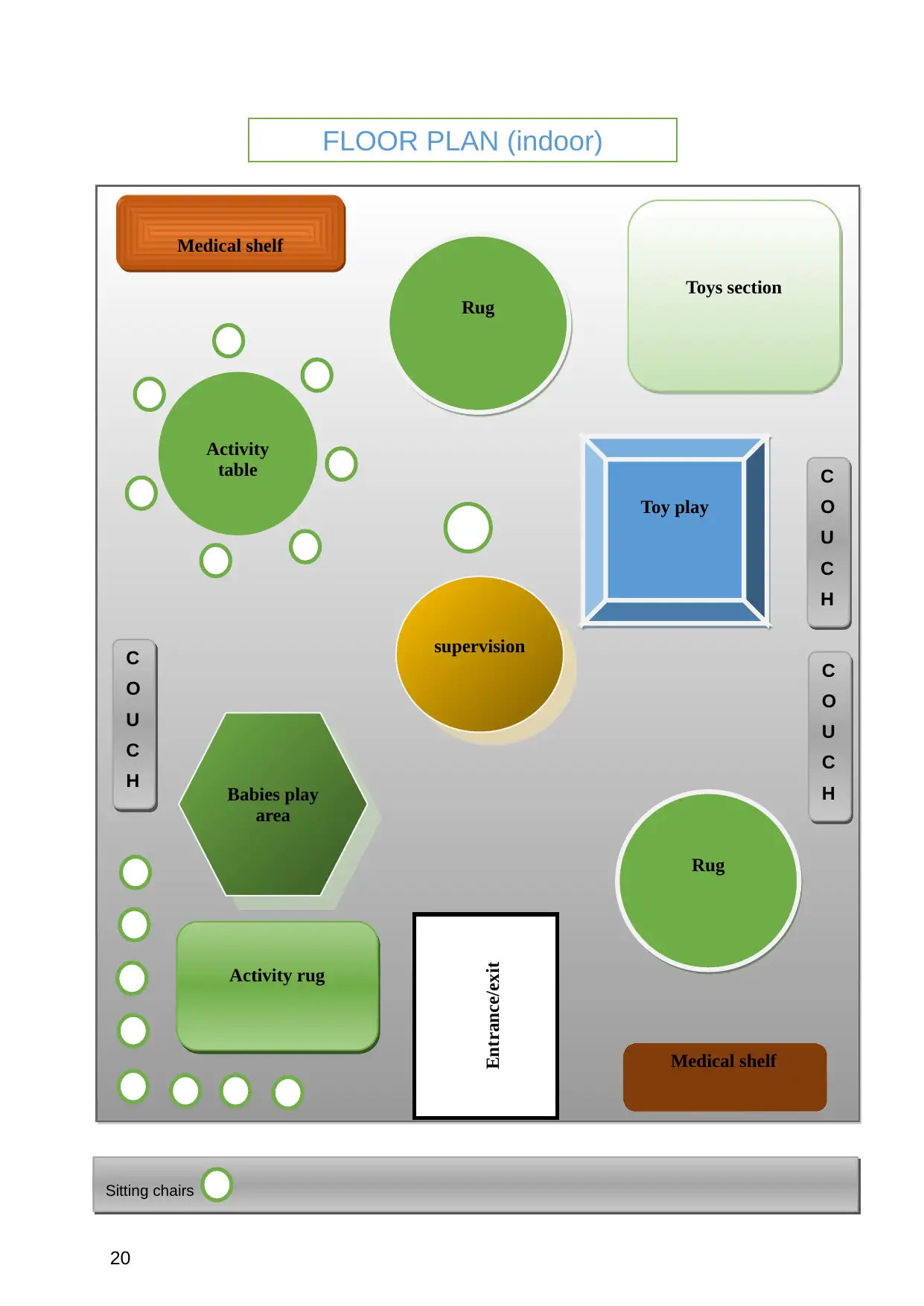
Medical shelf
20
FLOOR PLAN (indoor)
Toys section
Activity
table
Entrance/exit
Medical shelf
supervision
C
O
U
C
H
C
O
U
C
H
Rug
Rug
Sitting chairs
Medical shelf
C
O
U
C
H Babies play
area
Activity rug
Toy play
20
FLOOR PLAN (indoor)
Toys section
Activity
table
Entrance/exit
Medical shelf
supervision
C
O
U
C
H
C
O
U
C
H
Rug
Rug
Sitting chairs
Medical shelf
C
O
U
C
H Babies play
area
Activity rug
Toy play
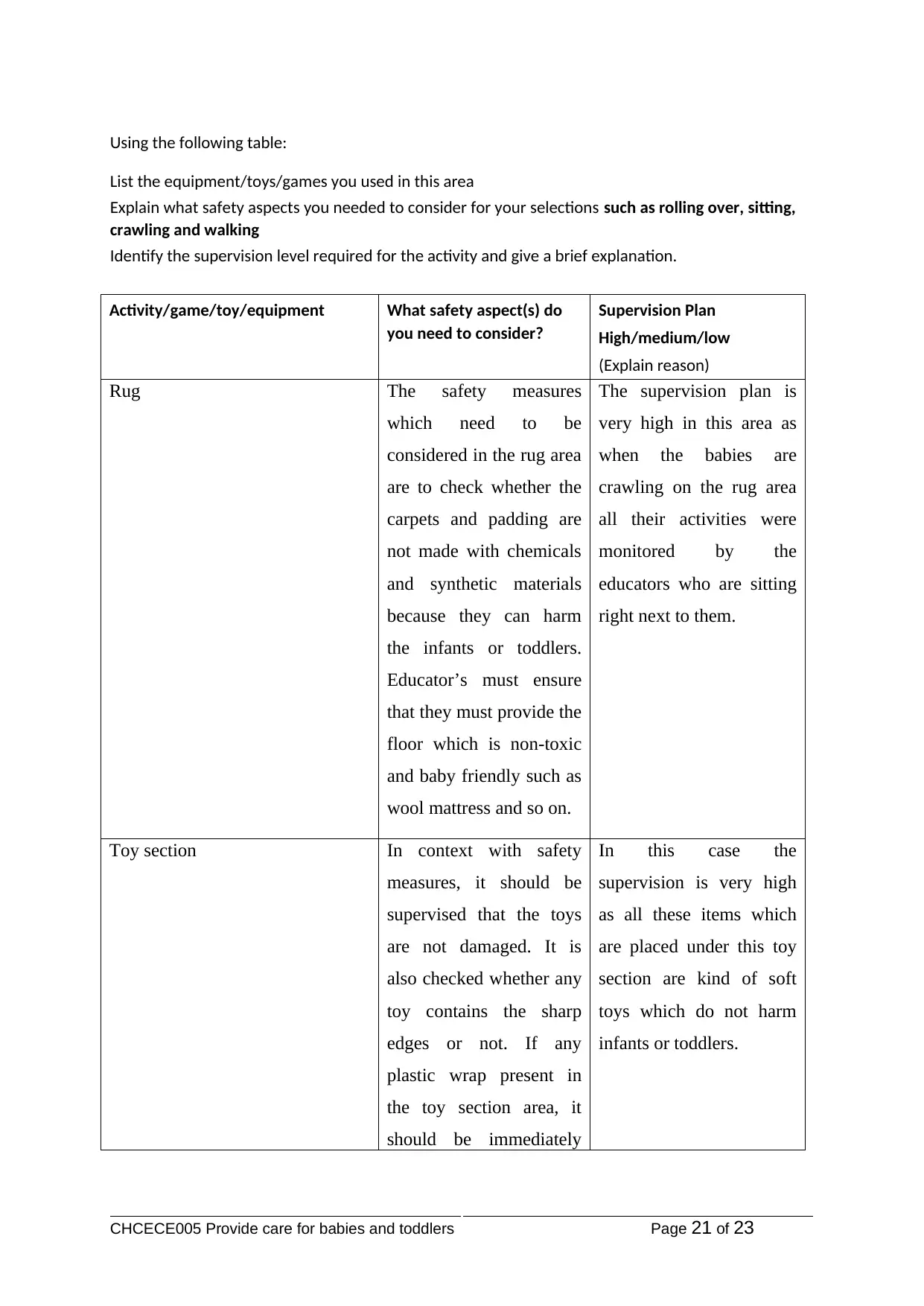
Using the following table:
List the equipment/toys/games you used in this area
Explain what safety aspects you needed to consider for your selections such as rolling over, sitting,
crawling and walking
Identify the supervision level required for the activity and give a brief explanation.
Activity/game/toy/equipment What safety aspect(s) do
you need to consider?
Supervision Plan
High/medium/low
(Explain reason)
Rug The safety measures
which need to be
considered in the rug area
are to check whether the
carpets and padding are
not made with chemicals
and synthetic materials
because they can harm
the infants or toddlers.
Educator’s must ensure
that they must provide the
floor which is non-toxic
and baby friendly such as
wool mattress and so on.
The supervision plan is
very high in this area as
when the babies are
crawling on the rug area
all their activities were
monitored by the
educators who are sitting
right next to them.
Toy section In context with safety
measures, it should be
supervised that the toys
are not damaged. It is
also checked whether any
toy contains the sharp
edges or not. If any
plastic wrap present in
the toy section area, it
should be immediately
In this case the
supervision is very high
as all these items which
are placed under this toy
section are kind of soft
toys which do not harm
infants or toddlers.
CHCECE005 Provide care for babies and toddlers Page 21 of 23
List the equipment/toys/games you used in this area
Explain what safety aspects you needed to consider for your selections such as rolling over, sitting,
crawling and walking
Identify the supervision level required for the activity and give a brief explanation.
Activity/game/toy/equipment What safety aspect(s) do
you need to consider?
Supervision Plan
High/medium/low
(Explain reason)
Rug The safety measures
which need to be
considered in the rug area
are to check whether the
carpets and padding are
not made with chemicals
and synthetic materials
because they can harm
the infants or toddlers.
Educator’s must ensure
that they must provide the
floor which is non-toxic
and baby friendly such as
wool mattress and so on.
The supervision plan is
very high in this area as
when the babies are
crawling on the rug area
all their activities were
monitored by the
educators who are sitting
right next to them.
Toy section In context with safety
measures, it should be
supervised that the toys
are not damaged. It is
also checked whether any
toy contains the sharp
edges or not. If any
plastic wrap present in
the toy section area, it
should be immediately
In this case the
supervision is very high
as all these items which
are placed under this toy
section are kind of soft
toys which do not harm
infants or toddlers.
CHCECE005 Provide care for babies and toddlers Page 21 of 23

thrown away. An
educator must read the
guidelines which are
written on the toys.
Activity table In the activity area, the
things which is required
to be considered as to
check no infant or toddler
make harm to them or
others. It is educator’s or
supervisor’s duty to
check whether the infants
or toddlers using the right
tool or not while they are
on activity table.
In this area, the
supervision level is quiet
high as the supervisor’s or
educators are also there
when they play activities
and also they check each
and every activity of
every infant.
Office use only
Assessor Feedback
Trainers Name, Date
22
educator must read the
guidelines which are
written on the toys.
Activity table In the activity area, the
things which is required
to be considered as to
check no infant or toddler
make harm to them or
others. It is educator’s or
supervisor’s duty to
check whether the infants
or toddlers using the right
tool or not while they are
on activity table.
In this area, the
supervision level is quiet
high as the supervisor’s or
educators are also there
when they play activities
and also they check each
and every activity of
every infant.
Office use only
Assessor Feedback
Trainers Name, Date
22
Secure Best Marks with AI Grader
Need help grading? Try our AI Grader for instant feedback on your assignments.
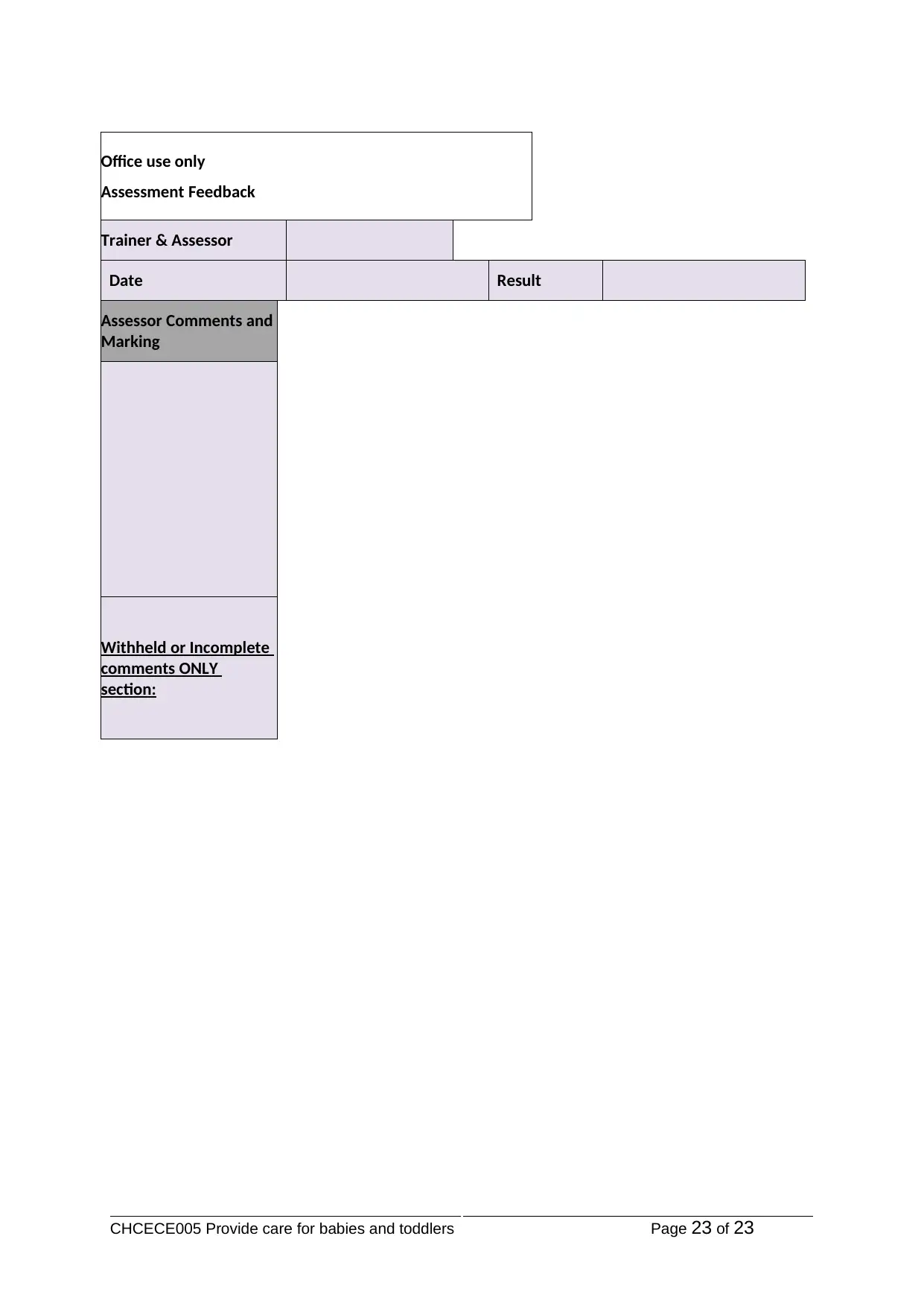
Office use only
Assessment Feedback
Trainer & Assessor
Date Result
Assessor Comments and
Marking
Withheld or Incomplete
comments ONLY
section:
CHCECE005 Provide care for babies and toddlers Page 23 of 23
Assessment Feedback
Trainer & Assessor
Date Result
Assessor Comments and
Marking
Withheld or Incomplete
comments ONLY
section:
CHCECE005 Provide care for babies and toddlers Page 23 of 23
1 out of 23
Related Documents
Your All-in-One AI-Powered Toolkit for Academic Success.
+13062052269
info@desklib.com
Available 24*7 on WhatsApp / Email
![[object Object]](/_next/static/media/star-bottom.7253800d.svg)
Unlock your academic potential
© 2024 | Zucol Services PVT LTD | All rights reserved.





